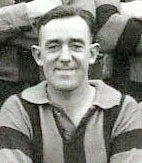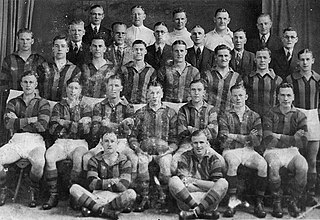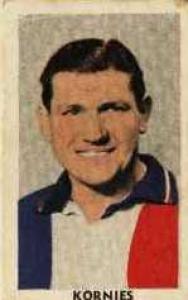Related Research Articles

The Victorian Football League (VFL) is the major state-level Australian rules football league in Victoria and, starting from 2021, New South Wales and Queensland. The league evolved from the former Victorian Football Association (VFA), and has been known by its current name since 1996. For historical purposes, the present VFL is sometimes referred to as the VFA/VFL, to distinguish it from the present day Australian Football League, which was known until 1990 as the Victorian Football League and is sometimes referred to as the VFL/AFL.

William Henry Hutchison, often referred to as "Hutchy", was an Australian rules footballer in the Victorian Football League (VFL) with the Essendon Football Club, who played 290 VFL games, from 1942 to 1957, and kicked 496 goals.
Prahran Assumption Football Club, nicknamed The Two Blues, is an Australian rules football club based at Toorak Park in Orrong Road between High Street and Malvern Road, Armadale, in Melbourne, Victoria, Australia. The club is currently in Division 1 of the Victorian Amateur Football Association (VAFA). The nickname Two Blues comes from the club uniform which has been royal blue and sky blue since the club formed in 1886.
Brighton Football Club was an Australian rules football club which played in the Victorian Football Association (VFA). The club was based in the Melbourne suburb of Brighton, and was nicknamed the Penguins. After suffering financial hardship throughout the 1950s, Brighton moved to Caulfield and later became the Caulfield Bears in the early to mid-1960s.
Camberwell Football Club was an Australian rules football club which formed around the mid 1880s, with a published match in 1886 and competed in the Victorian Football Association (VFA) between 1926 and 1990. Nicknamed the Cobras, Camberwell wore blue, white and red club colours. They were based in the Melbourne suburb of Camberwell.

Thomas 'Tommy' 'Turk' Lahiff was an Australian rules footballer who played with Essendon, South Melbourne and Hawthorn in the Victorian Football League (VFL) and for Port Melbourne in the Victorian Football Association (VFA), before becoming a successful coach and radio commentator.

Australian rules football was one of two demonstration sports at the 1956 Summer Olympics held in Melbourne.
The 1912 Victorian Football Association season was the 36th season of the Australian rules football competition. The premiership was won for the second consecutive time by the Essendon (Association) Football Club, after it defeated Footscray in the Grand Final by 21 points on 28 September. It was the club's second and last VFA premiership.

The 1940 Victorian Football Association season was the 62nd season of the Australian rules football competition. The premiership was won by the Port Melbourne Football Club, which defeated Prahran by 47 points in the Grand Final on 5 October. It was Port Melbourne's first VFA premiership since 1922, and its fourth overall.

The 1949 Victorian Football Association season was the 68th season of the Australian rules football competition. The premiership was won by the Williamstown Football Club, which defeated Oakleigh by three points in the Grand Final on 1 October. It was the fifth premiership won by the club.
The 1950 Victorian Football Association season was the 69th season of the Australian rules football competition. The premiership was won by the Oakleigh Football Club, which defeated Port Melbourne by 19 points in the Grand Final on 30 September. It was the third premiership won by the club.
The 1951 Victorian Football Association season was the 70th season of the Australian rules football competition. The premiership was won by the Prahran Football Club, after it defeated Port Melbourne by nine points in the Grand Final on 6 October. It was Prahran's second VFA premiership.

The 1953 Victorian Football Association season was the 72nd season of the Australian rules football competition. The premiership was won by the Port Melbourne Football Club, after it defeated Yarraville by 60 points in the Grand Final on 3 October. It was Port Melbourne's seventh VFA premiership, and it was the only premiership that the club won during a sequence of eight consecutive Grand Finals played from 1950 until 1957, and five consecutive minor premierships won from 1951 until 1955.
Robert "Bob" Bonnett was an Australian rules footballer who played with the Port Melbourne Football Club in the Victorian Football Association (VFA) in the 1950s and 1960s.

Ivor Thomas McIvor was an Australian rules footballer who played with Essendon in the Victorian Football League (VFL).
Edward Ronald Jory was an Australian rules footballer who played with Essendon in the Victorian Football League (VFL).
Ken Seymour is a former Australian rules footballer who played with Fitzroy and South Melbourne in the Victorian Football League (VFL).
Frank Brew was an Australian rules footballer who played with South Melbourne in the Victorian Football League (VFL).
The Australian rules football schism (1938–1949) was a period of division in the rules and governance of Australian rules football, primarily in the sport's traditional heartland of Melbourne, and to lesser extents in North West Tasmania and parts of regional Victoria. The schism existed primarily between Melbourne's pre-eminent league, the Victorian Football League (VFL), and its secondary league, the Victorian Football Association (VFA). In the context of VFA history, this period is often referred to as the throw-pass era.
William George Wells was an Australian rules footballer who played with North Melbourne and St Kilda in the Victorian Football League (VFL). He was injured during the war and told he was expected to spend the remainder of his life in a wheelchair, but made a successful comeback. After leaving the VFL he played for various clubs, including three stints with Williamstown in the Victorian Football Association (VFA). He also coached in the Wimmera Football League and Ballarat Football League.
References
- ↑ "Tomorrow's men will be watched". The Argus. Melbourne. 12 July 1952. p. 5.
- ↑ H. A. deLacy (28 June 1950). "New vision has helped Rules man". The Courier-Mail. p. 10.
- 1 2 Percy Taylor (12 June 1950). "...from the World of Sport". The Argus. Melbourne. p. 13.
- ↑ Pivot (24 July 1950). "Expensive lenses help short-sighted captain". The Daily News. Perth, WA. p. 15.
- ↑ Bruce Welch (23 April 1951). "Dispute with club over payment". The Age. Melbourne. p. 14.
- ↑ "Brunswick lift Whelan ban". The Argus. Melbourne. 9 May 1951. p. 14.
- ↑ "Whelan to lead V.F.A. again". The Argus. Melbourne. 18 June 1951. p. 9.
- ↑ "Whelan cleared to Euroa". The Argus. Melbourne. 7 February 1952. p. 11.
- ↑ Percy Beames (9 April 1954). "North gets limited permit for Templar". The Age. Melbourne. p. 10.